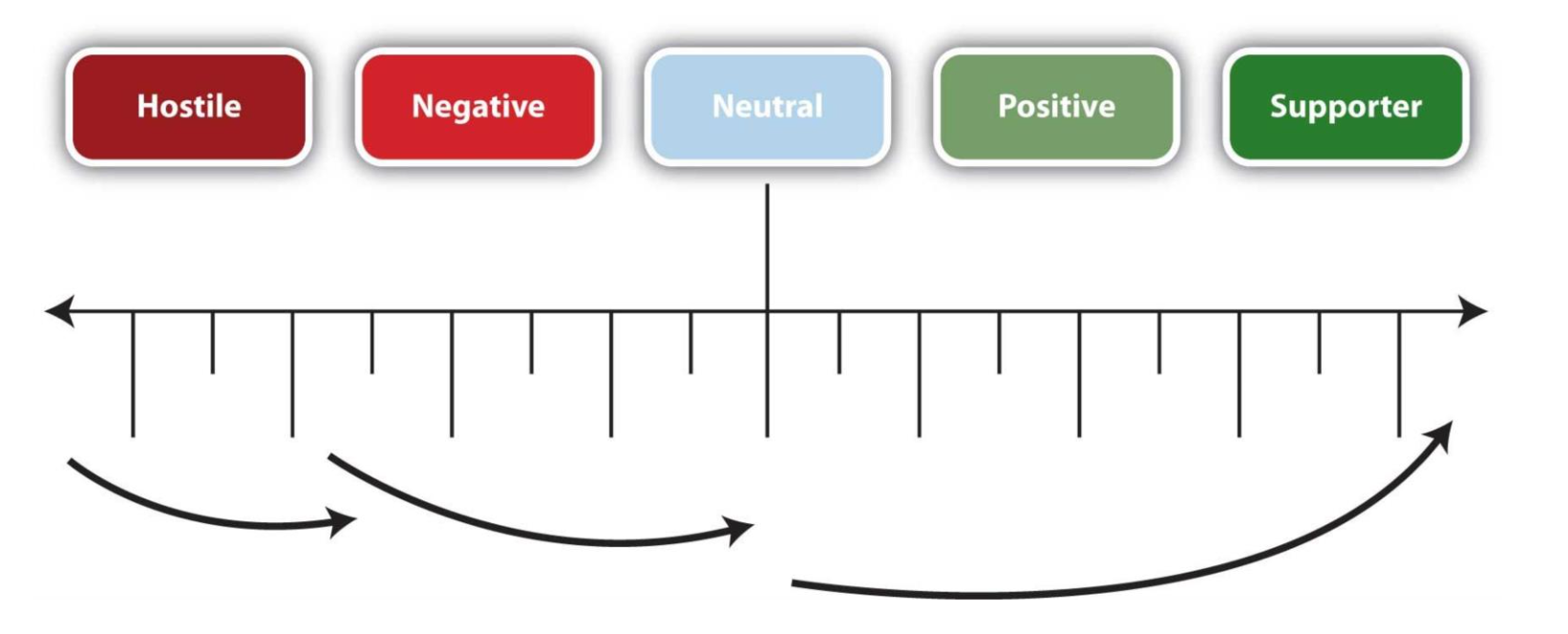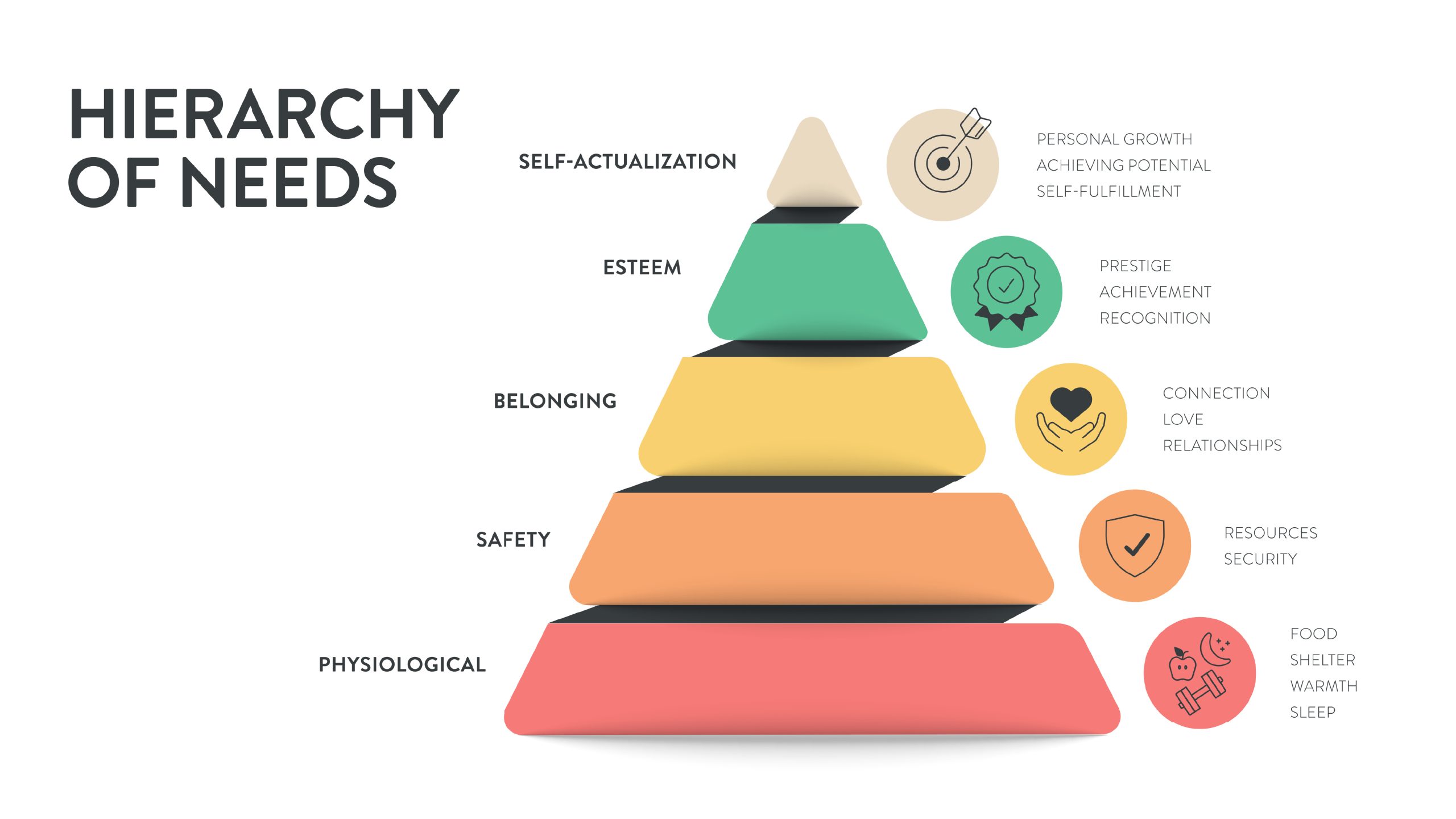Chapter 15: Persuasive Presentations
Chapter Learning Objectives
- 15.1 Define persuasion and distinguish it from motivation in the context of professional communication. (SLO 1, 2, 4)
- 15.2 Apply Maslow’s Hierarchy of Needs to craft persuasive messages that address the audience’s basic and growth needs effectively. (SLO 1, 2, 4)
- 15.3 Analyze ethical considerations in persuasive communication, including how to avoid manipulation, deception, and logical fallacies when presenting arguments. (SLO 1, 2, 4, 5)

No doubt there has been a time when you wanted something from your parents, your supervisor, or your friends, and you thought about how you were going to present your request. But do you think about how often people—including people you have never met and never will meet—want something from you?
When you watch television, advertisements reach out for your attention, whether you watch them or not. When you use the Internet, pop-up advertisements and website suggestions often appear. Living in many parts of the world means that you have been surrounded, even inundated, by persuasive messages. Our communication ecosystem effects how we view the world:
Consider these facts:
- By age eighteen, the average American teenager will witness on television 200,000 acts of violence, including 40,000 murders (Huston et al., 1992).
- The average person sees between four hundred and six hundred ads per day—that is forty million to fifty million by the time he or she is sixty years old. One of every eleven commercials has a direct message about beauty (Raimondo, 2010).
- By age eighteen, the average American teenager will have spent more time watching television—25,000 hours—than learning in a classroom (Ship, 2005).
- Forty percent of nine- and ten-year-old girls have tried to lose weight, according to an ongoing study funded by the National Heart, Lung and Blood Institute (Body image and nutrition: Fast facts, 2009).
- Identification with television stars (for girls and boys), models (girls), or athletes (boys) positively correlated with body dissatisfaction (Hofschire & Greenberg, 2002).
- At age thirteen, 53 percent of American girls are “unhappy with their bodies.” This grows to 78 percent by the time they reach seventeen (Brumber, 1997).
- #Fitspiration and #Thinspiration images on Instagram promote decreased self-esteem and self-perceptions among college age women (Chansiri & Wongphothiphan, 2021).
- Usage of mobile dating apps relates to and self-perceived masculinity, internalized homonegativity, and body dissatisfaction among men who have sex with men (Miller & Behm-Morawitz, 2020).
The communication ecosystem has messages in narrative form, in stories, in hashtags, and in political speeches. You have learned many of the techniques by trial and error and through imitation. If you ever wanted the keys to your parents’ car for a special occasion, you used the principles of persuasion to reach your goal.
What is Persuasion?
Persuasion is an act or process of presenting arguments to move, motivate, or change your audience. Aristotle taught that rhetoric, or the art of public speaking, involves the faculty of observing in any given case the available means of persuasion (Covino & Jolliffe, 1995).
A teenager trying to persuade their parents to lend them the car keys, they may have asked one parent instead of the other. This was done by calculating the probable response of each parent and electing to approach the one who was more likely to adopt the teenager’s position (and ultimately give them the keys). Persuasion can be implicit or explicit and can have both positive and negative effects. In this chapter we’ll discuss the importance of ethics when presenting your audience with arguments in order to motivate them to adopt your view, consider your points, or change their behavior.

Motivation is distinct from persuasion in that it involves the force, stimulus, or influence to bring about change. Persuasion is the process, and motivation is the compelling stimulus that encourages your audience to change their beliefs or behavior, to adopt your position, or to consider your arguments.
Why think of yourself as fat or thin? Why should you choose to spay or neuter your pet? Messages about what is beautiful, or what is the right thing to do in terms of your pet, involve persuasion, and the motivation compels you to do something.
You may have heard a speech where the speaker tried to persuade you, tried to motivate you to change, but you resisted the message. Use this perspective to your advantage and consider why an audience should be motivated, and you may find the most compelling examples or points. Relying on positions like “I believe it, so you should too,” “Trust me, I know what is right,” or “It’s the right thing to do” may not be explicitly stated but may be used with limited effectiveness. Why should the audience believe, trust, or consider the position “right?” Keeping an audience-centered perspective as you consider your persuasive speech to increase your effectiveness.
You may think initially that many people in your audience would naturally support your position in favor of spaying or neutering your pet. After careful consideration and audience analysis, however, you may find that people are more divergent in their views. Some audience members may already agree with your view, but others may be hostile to the idea for various reasons. Some people may be neutral on the topic and look to you to consider the salient arguments. Your audience will have a range of opinions, attitudes, and beliefs across a range from hostile to agreement. Your arguments to successfully persuade others must start from understanding others’ ideas as well as your own.
Science of Persuasion
Video: Science Of Persuasion
Watch this animated video by Dr. Robert Cialdini to learn about the six universal principles of persuasion that have been scientifically proven to make you most effective in persuasion.
Measurable Gain
Rather than thinking your job is to get everyone to agree with you, look at the concept of measurable gain. This is an idea of assessing the extent to which audience members respond to a persuasive message. The goal in each case is to move the audience members toward your position. Some change may be small but measurable, and that is considered gain.
You may reinforce existing beliefs in the members of the audience that agree with you and do a fine job of persuasion. You may also get hostile members of the audience to consider one of your arguments and move from a hostile position to one that is more neutral or ambivalent. The next time a hostile audience member considers the issue, they may be more open to it. Figure 1 is a useful diagram to illustrate the concept of measurable gain.
The situation in which a conversation occurs provides a lot of meaning and understanding for the participants. This ability to understand motivation and context is key to good communication, and one we will examine throughout this chapter.
Meeting the Listener’s Basic Needs
This section explores why we communicate, illustrating how meeting the listener’s basic needs is central to effective communication. It’s normal for the audience to consider why you are persuading them, and there is significant support for the notion that by meeting the audience’s basic needs, whether they are a customer, colleague, or supervisor, you will more effectively persuade them to consider your position.
Not all oral presentations involve taking a position, or overt persuasion, but all focus on the inherent relationships and basic needs within the business context. Getting someone to listen to what you have to say involves a measure of persuasion and getting that person to act on it might require considerable skill.
Whether you are persuading a customer to try a new product or service, or informing a supplier that you need additional merchandise, the relationship is central to your communication. The emphasis inherent in our next two discussions is that we all share this common ground, and by understanding that we share basic needs, we can better negotiate meaning and achieve understanding.
The table below presents some reasons for engaging in communication. As you can see, the final item in the table indicates that we communicate in order to meet our needs.
Click on each Goal heading below to read more about why we engage in communication:
Gain Information
We engage in communication to gain information. This information can involve directions to an unknown location, or a better understanding about another person through observation or self-disclosure.
Understand Communication Contexts
We also want to understand the context in which we communicate, discerning the range between impersonal and intimate, to better anticipate how to communicate effectively in each setting.
Understand Our Identity
Through engaging in communication, we come to perceive ourselves, our roles, and our relationships with others.
Meet Our Needs
We meet our needs through communication.
In persuasion, your audience will share with you a need for control. You can help meet this need by constructing your speech with an effective introduction, references to points you’ve discussed, and a clear conclusion. The introduction will set up audience expectations of points you will consider and allow the audience to see briefly what is coming.
Your internal summaries, signposts, and support of your main points all serve to remind the audience what you’ve discussed and what you will discuss. Finally, your conclusion answers the inherent question, “Did the speaker actually talk about what they said they were going to talk about?” and affirms to the audience that you have fulfilled your objectives.
Maslow’s Motivational Model
If you have taken courses in anthropology, philosophy, psychology, or perhaps sociology in the past, you may have seen Maslow’s hierarchy of needs (Figure 3). Psychologist Abraham Maslow studied with the Blackfoot Native American’s in the 1930’s and borrowed their Tipi model of understanding human development to create his hierarchy of needs (Taylor, 2019). provides seven basic categories for human needs, and arranges them in order of priority, from the most basic to the most advanced.
We know human beings need energy, water, and air to live. Without any of these three basic elements, which meet our physiological needs, we cannot survive. Therefore, physiological needs are at the base of the pyramid. We need to meet them before anything else and will often sacrifice everything else to get them.
Once we have what we need to live, we seek safety. Having resources like shelter and the security to stay safe is the next level of the pyramid. In order to leave a hostile living environment, people may place the well-being and safety of another over their own needs, in effect placing themselves at risk. An animal would fight for its own survival above all else, but humans can and do acts of heroism that directly contradict their own self-interest. Our own basic needs motivate us, but sometimes the basic needs of others are more important to us than our own.
We seek affection from others once we have the basics to live and feel safe from immediate danger. We look for a sense of love and belonging. All needs in Maslow’s model build on the foundation of the previous needs, and the third level reinforces our need to be a part of a family, community, or group. This is an important step that directly relates to business communication. If a person feels safe at your place of business, they are more likely to be open to communication.
Communication is the foundation of the business relationship, and without it, you will fail. If they feel on edge, or that they might be pushed around, made to feel stupid, or even unwanted, they will leave, and your business will disappear. On the other hand, if you make them feel welcome, provide multiple ways for them to learn, educate themselves, and ask questions in a safe environment, you will form relationships that transcend business and invite success.
Once we have been integrated in a group, we begin to assert our sense of self and self-respect, addressing our need for self-esteem. Self-esteem is essentially how we feel about ourselves. Imagine you had taken up biking, but your first task was to climb a steep hill. Afterwards you may think “biking is not for me” or feel defeated. Your feelings of self-worth tied to experiences capture different facets of your self-esteem. But, self-esteem describes the collection of several experiences which make up your feelings about your own ability and worth. Self-esteem reinforces safety and familiarity, belonging to a group or perceiving a trustworthy support system, and the freedom to make mistakes.
Growth Needs
The top levels of Maslow’s hierarchy are called growth needs. Think of these needs in terms of how we feel about ourselves and our ability to assert control and influence over our lives. Once we are part of a group and have begun to assert ourselves, we start to feel as if we have reached our potential and are actively making a difference in our own world. This is called self-actualization. Self-actualization can involve reaching your full potential, feeling accepted for who you are, and perceiving a degree of control or empowerment in your environment. It may mean the freedom to go beyond building the bird house to the tree house, and to design it yourself as an example of self-expression.
As we progress across these levels of the pyramid, our basic human curiosity about the world around us emerges. When we have our basic needs met, we do not need to fear losing our place in a group or access to resources. We are free to explore and play, discovering the world around us. Our need to know motivates us to grow and learn.
Maslow’s hierarchy demonstrates how our most basic needs are quite specific, and as we progress through the levels, the level of abstraction increases until ultimately, we feel more comfortable engaging in more abstract and personally fulfilling needs. As we increase our degree of interconnectedness with others, we become interdependent and, at the same time, begin to express independence and individuality.
As a boss, a co-worker, even a speaker at an event, you ought to consider where your message will appeal to the audience. Some listeners need motivation and encouragement for basic needs. Others will connect to ideas of growth, fulfillment, curiosity, etc. The more that your persuasive message appeals to the specific audience’s needs, the more likely you will find measurable gain.
Eleven Points for Speaking Ethically
In his book Ethics in Human Communication, Richard Johannesen (1996) offers eleven points to consider when speaking to persuade. His main points reiterate many of the points across this chapter and should be kept in mind as you prepare, and present, your persuasive message.
Do NOT:
- Use false, fabricated, misrepresented, distorted or irrelevant evidence to support arguments or claims.
- Intentionally use unsupported, misleading, or illogical reasoning.
- Represent yourself as informed or an “expert” on a subject when you are not.
- Use irrelevant appeals to divert attention from the issue at hand.
- Ask your audience to link your idea or proposal to emotion-laden values, motives, or goals to which it is actually not related.
- Deceive your audience by concealing your real purpose, by concealing self-interest, by concealing the group you represent, or by concealing your position as an advocate of a viewpoint.
- Distort, hide, or misrepresent the number, scope, intensity, or undesirable features of consequences or effects.
- Use “emotional appeals” that lack a supporting basis of evidence or reasoning.
- Oversimplify complex, gradation-laden situations into simplistic, two-valued, either-or, polar views or choices.
- Pretend certainty where tentativeness and degrees of probability would be more accurate.
- Advocate something which you yourself do not believe in.
In your attempt to persuade, consider honesty and integrity as you assemble your arguments. Your audience will appreciate your thoughtful consideration of more than one view, your understanding of the complexity, and you will build your ethos, or credibility, as you present. Be careful not to stretch the facts, or assemble them only to prove yourself, and instead prove the argument on its own merits. Deception, coercion, intentional bias, manipulation and bribery have no place in your speech to persuade.
Basic Elements of a Persuasive Message
Exercises
Flip each card to read the steps to creating a persuasive message.
A simple organizational pattern can help you focus on the basic elements of a persuasive message when time is short, and your performance is critical.
Conclusion
In short, you need to prepare and practice if you expect to present a compelling and persuasive argument. The goal of a measurable gain is considered gain, even if you do not get your audience to agree with your point right away.
How to cite this chapter:
Piercy, C. (2021). Chapter 15: Persuasive Presentations. In Pouska, B. (Ed.), Business Professionalism. New Mexico Open Educational Resources Consortium Pressbooks. https://nmoer.pressbooks.pub/businessprofessionalism/
Licenses and Attributions
References
Albertson, E. (2008). How to open doors with a brilliant elevator speech. New Providence, NJ: R. R. Bowker.
Altman, I., & Taylor, D. (1973). Social penetration: The development of interpersonal relationships. New York, NY: St. Martin’s Press.
Teen Health and the Media. (2009). Body image and nutrition: Fast facts. Retrieved from the University of Washington.
Brumberg, J. J. (1997). The body project: An intimate history of American girls. New York, NY: Random House.
Chansiri, K., & Wongphothiphan, T. (2021). The indirect effects of Instagram images on women’s self-esteem: The moderating roles of BMI and perceived weight. New Media & Society. https://doi.org/10.1177/14614448211029975
Covino, W. A., & Jolliffe, D. A. (1995). Rhetoric: Concepts, definitions, boundaries. Boston, MA: Allyn & Bacon.
DuRant, R. H. (1997). Tobacco and alcohol use behaviors portrayed in music videos: Content analysis. American Journal of Public Health, 87, 1131–1135.
Dwyer, K. K., & Davidson, M. M. (2012). Is public speaking really more feared than death? Communication Research Reports, 29(2), 99–107.
Frommer, F. (2012). How PowerPoint makes you stupid (G. Holoch, Trans.). New York, NY: The New Press.
Hall, E. (1966). The hidden dimension. New York, NY: Doubleday.
Hasson, U., Hendler, T., Bashat, D. B., & Malach, R. (2001). Vase or face? Neural correlates of shape-selective grouping processes in the human brain. Journal of Cognitive Neuroscience, 13(6), 744–753.
Hofschire, L. J., & Greenberg, B. S. (2002). Media’s impact on adolescents’ body dissatisfaction. In D. Brown, J. R. Steele, & K. Walsh-Childers (Eds.), Sexual teens, sexual media. Mahwah, NJ: Lawrence Erlbaum Associates.
Howell, L. (2006). Give your elevator speech a lift. Bothell, WA: Publishers Network.
Huston, A. C., et al. (1992). Big world, small screen: The role of television in American society. Lincoln, NE: University of Nebraska Press.
Johannesen, R. (1996). Ethics in human communication (4th ed.). Prospect Heights, IL: Waveland Press.
Lauer, D. A., & Pentak, S. (2000). Design basics (5th ed.). Fort Worth, TX: Harcourt College Publishers.
Maier, D., Li, J., Tucker, P., Tufte, K., & Papadimos, V. (2005). Semantics of data streams and operators. Database Theory – ICDT 2005 Proceedings, 3363, 37–52.
Maslow, A. (1970). Motivation and personality (2nd ed.). New York, NY: Harper & Roe.
Miller, B., & Behm-Morawitz, E. (2020). Investigating the cultivation of masculinity and body self-attitudes for users of mobile dating apps for men who have sex with men. Psychology of Men & Masculinities, 21(2), 266–277. https://doi.org/10.1037/men0000221
Raimondo, M. (2010). About-Face facts on the media. About-Face.
Ship, J. (2005, December). Entertain. Inspire. Empower. How to speak a teen’s language, even if you’re not one. ChangeThis. http://www.changethis.com/pdf/20.02.TeensLanguage.pdf
Taylor, S. (2019). Original influences: How the ideas of America were shaped by Native Americans. Psychology Today. https://www.psychologytoday.com/us/blog/out-the-darkness/201903/original-influences
Tiggemann, M., & Pickering, A. S. (1996). Role of television in adolescent women’s body dissatisfaction and drive for thinness. International Journal of Eating Disorders, 20, 199–203.
Tufte, E. (2005). PowerPoint does rocket science–and better techniques for technical reports.
Original Chapter Source
Original chapter source: Adapted from Problem Solving in Teams and Groups by Cameron W. Piercy, PhD.



